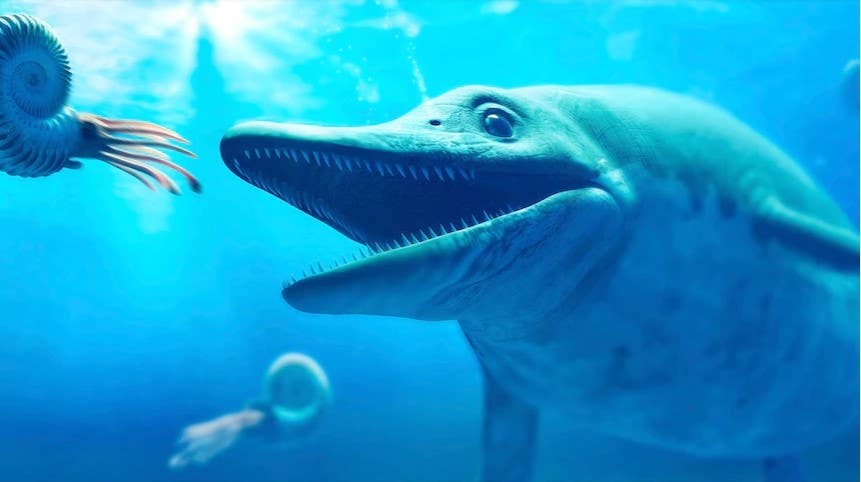Prehistoric marine giants found 2,800 meters above sea level
The first ichthyosaurs swam through the primordial oceans in the early Triassic period about 250 million years ago and weighed 80 tons.

[Apr 30, 2022: Svenja Ronge, University of Bonn]
Ichthyosaurs were among the earliest marine reptiles, first appearing around 250 million years ago. (CREDIT: AFP: Mark Garlick/Science Photo Library)
The first ichthyosaurs swam through the primordial oceans in the early Triassic period about 250 million years ago. They had an elongated body and a relatively small head.
But shortly before most of them became extinct some 200 million years ago (only the familiar dolphin-like species survived until 90 million years ago), they evolved into gigantic forms. With an estimated weight of 80 tons and a length of more than 20 meters, these prehistoric giants would have rivaled a sperm whale. However, they left scarcely any fossil remains - "why that is remains a great mystery to this day," stresses Prof. Dr. Martin Sander from the Section Paleontology at the Institute of Geosciences at the University of Bonn.
Folding of the Alps brought up fossils from the bottom of the sea
The finds now examined come from the Grisons (canton of Graubünden). Sander's colleague Dr. Heinz Furrer of the University of Zurich had recovered them together with students between 1976 and 1990 during geological mapping in the Kössen Formation. More than 200 million years before, the rock layers with the fossils still covered the seafloor. With the folding of the Alps, however, they had ended up at an altitude of 2,800 meters. "Maybe there are more rests of the giant sea creatures hidden beneath the glaciers," Sander hopes.
Martin Sander and Michael Hautmann look over the discovery layers on the southern slope of Schesaplana, on the Graubünden/Vorarlberg border. (CREDIT: Jelle Heijne/University of Bonn)
Related Stories
The paleontologist first held the fossilized bones in his hands three decades ago. At that time, he was still a doctoral student at the University of Zurich. In the meantime, the material had been somewhat forgotten. "Recently, though, more remains of giant ichthyosaurs have appeared," the researcher explains. "So it seemed worthwhile to us to analyze the Swiss finds again in more detail as well."
According to the study, the fossils come from three different animals that lived about 205 million years ago. From one of the ichthyosaurs, a vertebra is preserved together with ten rib fragments. Their sizes suggest that the reptile was probably 20 meters in length. In contrast, only a series of vertebrae were excavated from a second ichthyosaur. Comparison with better preserved skeletal finds suggests a length of about 15 meters.
"From our point of view, however, the tooth is particularly exciting," explains Sander. "Because this is huge by ichthyosaur standards: Its root was 60 millimeters in diameter - the largest specimen still in a complete skull to date was 20 millimeters and came from an ichthyosaur that was nearly 18 meters long." His colleague Heinz Furrer is delighted with the belated appreciation of the spectacular remains from the Swiss Alps: "The publication has confirmed that our finds at the time belonged to the world's longest ichthyosaur; with the thickest tooth found to date and the largest trunk vertebra in Europe!"
However, it is unlikely that the animals that populated the primordial oceans 205 million years ago were much longer than previously thought. "The tooth diameter cannot be used to directly infer the length of its owner," emphasizes paleontologist Martin Sander from Bonn. "Still, the find naturally raises questions."
Predators larger than a sperm whale are not really possible
This is because research assumes that extreme gigantism and a predatory lifestyle (which requires teeth) are incompatible. There is a reason why the largest animal of our time is toothless: the blue whale, which can be up to 30 meters long and weighs 150 tons. Next to it, the teeth-bearing sperm whale (20 meters and 50 tons) looks like an adolescent.
While the blue whale filters tiny creatures from the water, the sperm whale is a perfect hunter. This means it requires a larger portion of the calories it consumes to fuel its muscles. "Marine predators therefore probably can't get much bigger than a sperm whale," Sander says.
It is thus possible that the tooth did not come from a particularly gigantic ichthyosaur - but from an ichthyosaur with particularly gigantic teeth.
Participating institutions:
The Section Paleontology of the Institute of Geosciences of the University of Bonn, the Paleontological Institute and Museum of the University of Zurich, and the Institute of Anatomy of the University of Bonn were involved in the study.
For more science and technology stories check out our New Discoveries section at The Brighter Side of News.
Note: Materials provided above by University of Bonn. Content may be edited for style and length.
Like these kind of feel good stories? Get the Brighter Side of News' newsletter.
Tags: #New_Discoveries, #Global_Good_News, #Reptile, #Prehistoric, #Dinosaurs, #Science, #Research, #Paleontology, #The_Brighter_Side_of_News
Joseph Shavit
Head Science News Writer | Communicating Innovation & Discovery
Based in Los Angeles, Joseph Shavit is an accomplished science journalist, head science news writer and co-founder at The Brighter Side of News, where he translates cutting-edge discoveries into compelling stories for a broad audience. With a strong background spanning science, business, product management, media leadership, and entrepreneurship, Joseph brings a unique perspective to science communication. His expertise allows him to uncover the intersection of technological advancements and market potential, shedding light on how groundbreaking research evolves into transformative products and industries.



